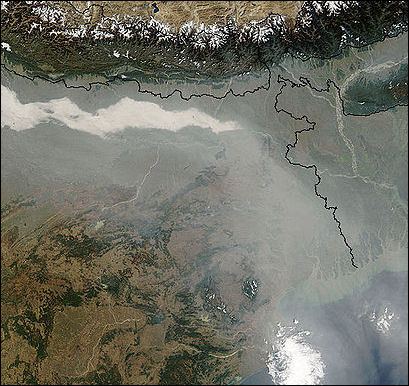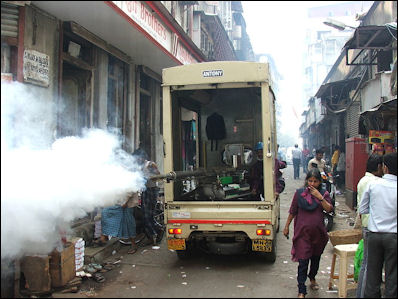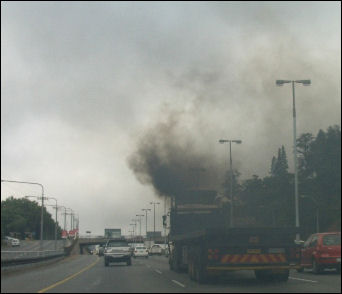ENVIRONMENTAL ISSUES IN THE DEVELOPING WORLD

Haze and smoke over Ganges basin in India Sustainability is an important concept and a goal among environmentalists. It describes the rate in which available resources are consumed. A situation is described as sustainable if resources can be replenished quicker than they can be consumed. Unsustainable refers to resources being consumed quicker than they can be replenished. Unsustainability is currently the norm. By one estimate it takes 14.4 months to replenish what people use in 12 months.
Among the major environmental problems that affect villagers directly are deforestation, water pollution, erosion, and salinization of the soil through over-irrigation.
Pollution is not a major political issue among people living in the developing world. For the rural poor the notion of being environmentally-friendly clashes with the need to find to food, water and fuel to cook with and heat their homes. As more people earn more money, they want to buy cars and eat more environmentally-destructive foods.
A good portion of the wildlife that once roamed around is gone. Leopards used to live all over Asia, and Africa. Elephants and hippopotamus's lived in the Middle East. During the Bronze Age ostriches and lions have lived as far north as Turkey. The only large mammals left today are a few brown bears, wolves and ibexes that live in the remote mountains.
Antole Kaletsky wrote in the Times of London, “Developing countries will not be able to dislodge environmental constraints so easily. They are either too poor, like most African countries, or too large, like China, India and Brazil...If these countries ever reach living standards remotely approaching those of today’s developed countries, they will create demand for food, energy and water so vast that other parts of the world will not be able to meet them in the long term...This will give developing countries an overwhelming incentive to invest in new technologies . To do this, they will have to undertake investments on an almost inconceivable scale.”
See Separate Article DESERTIFICATION AND SOLUTIONS TO DESERT ENVIRONMENTAL PROBLEMS factsanddetails.com
Forests, Wet and Dry Seasons, Trees and National Parks
Leucaena trees are greatly prized. They grow fast (three feet year), produces deep soil-stabilizing roots, adds nitrogen to the soil, supplies animal fodder, and grows back quickly if branches are cut off for charcoal. The only drawback is that the cause otherwise healthy animals who eat them to loose their hair.
Population increases are causing human encroachment on the game parks, which are vital for bringing in tourists and money. Half the world’s 17,000 major wildlife refuges are being heavily used for agriculture or livestock.
People live in and around national parks and use resources in the park. The notion that resources in the parks can't be touched is unenforceable.
Many places have wet and dry seasons. During the dry season fodder for goats and sheep is so scarce that families are forced to climb trees and throw leaves down to their animals and land is often baked so hard that farmers have to wait for seasonal rains to dampen the ground before it can be plowed.
Deforestation
Trees are cut down in deforested areas mainly for fuel and to make way for agricultural land. In many places forest have been replaced by expanses of elephant grass and eroded gullies and rocky ravines.
Fuel wood consumption is increasing at an alarming rate. People often have little choice but to cut down forests for building materials and firewood. No alternative fuels and building materials are provided. In prehistoric times the land was covered with forests, but these trees were cut down long ago.
Floods and landslides kill lots of people. Erosion and deforestation caused by loggers and villagers collecting firewood and practicing slash and burn agriculture exacerbate the problem.
See Separate Articles: RAINFOREST DEFORESTATION: RATES, RESULTS AND ALARM factsanddetails.com; CAUSES OF RAINFOREST DEFORESTATION factsanddetails.com; PEOPLE IN THE RAINFOREST: INDIGENOUS TRIBES, SETTLERS AND SLASH-AND-BURN AGRICULTURE factsanddetails.com; COMBATING DEFORESTATION AND EFFORTS TO SAVE THE RAINFOREST factsanddetails.com;
Lack of Toilets and Sanitation in the Developing World
Two out of every five people in the world have no access to safe toilets. Rather than using flush toilets they use open pits or latrines that flush waste into the streets or simply go in a nearby field. Places with sewers often have no waste-water treatment facilities and sewage is dumped directly into water supplies from which people draw their water.
According to the United Nations poor sanitation kills 1.5 million children a year. Most die of diarrhea from drinking contaminated water. Diarrhea is the world’s No.2 leading killer of children. Poor sanitation is also blamed for the spread of intestinal worms, pneumonia and cholera. Studies have shown that providing clean water offers tremendous benefits. Health costs go down. People live longer, stay healthier and are more productive. But often there is little political will to invest in sanitation.
Jack Sim, a retired real estate entrepreneur and founder of the World Toilet Organization, has made it his goal to improve health in the developing world by introducing more toilets to villages. He said the biggest obstacle that needs to be overcome is the embarrassment factor. He told Time, “It’s a question of marketing toilets as a status symbol. I want people to aspire to owning a toilet.” As a starting point he has been promoting ecologically-sound latrines, which can cost as little as $10 a piece. Sim is also working with fertilizer businesses and engineers on effective ways to collect waste and use it to grow crops and generate biogas for cooking stoves.
See Separate Article TOILETS AND SANITATION IN THE DEVELOPING WORLD factsanddetails.com
Toxic Materials and High Tech Waste

Malaria spraying in Mumbai Some developing countries have become dumping grounds for toxic materials from rich countries. International attention on issue has led to a cut back of the practice. See Cambodia, China
DDT is still used in many developing countries primarily because it is effective in controlling mosquitos that carry the malaria parasite.
Other developing countries have become dumping ground for computers, refrigerators, cars, plastic bottles and paper. Refrigerators contain ozone-layer-deleting CFCs; computers and electronic good contain materials that can be recycled but also contain many harmful materials. Circuit boards sometimes contain PCBs. Monitors often contain lead, barium and other heavy metals while many components contain mercury and phosphorus.
Discarded televisions and computers can be a nasty addition to the environment. A cathode ray tube — which is categorized as toxic waste by the U.S. Environmental Protection Agency — can contain up to 3½ kilograms of lead and chemicals such as barium and phosphorous. LCDs in flat screen television and laptops contain less toxic materials than cathode-ray tubes but have mercury in the lamps that backlight the screens. Personal computers contain toxic substances such as lead, beryllium and hexavalent chromium.
Recycling
Recycling is done by the trash collectors. They sort through the garbage and separate out what they need. They sell the recyclable materials at recycling centers. People are very good about returning their bottles if they get some money in return.
Some of the urban poor who do the best live on the fringes of affluent areas and make a living scavenging trash. In many places, recently arrived migrants from the countryside, desperate for any source of income they can find, start out collecting trash which they sell to recycling contractors. This system allows city governments to collect and recycle trash for practically nothing. In some cities in developing countries "one to percent of the population is supported directly or indirectly by the refuge for the from the upper 10 to 20 percent."
Dams in the Developing World
Dams have been built to control flooding, improve transportation, generate electricity and provide water for irrigation and other uses.
The world’s 45,000 large dams catch 14 percent of all precipitation runoff, provide water for up to 40 percent of irrigated land and give 65 countries more than half of their electricity.
Large numbers rural people have lost their homes as a result of hydroelectric dam projects. Some have been evicted from their land and received little or no compensation. Without a means of making a living, many of the displaced people migrate to the cities.
A number of countries have had success with microhydroelectric plants. The systems — set up with support of local people — divert waters from streams and rivers to run turbines with complex dams and catchment areas. Plants produce up to 200 kilowatts, enough to provide electricity for 200 to 500 homes.
Air Pollution

dirty truck in South Africa Air pollution includes particles of soot, organic hazardous material, heavy metals, acid aerosols and dust. The smaller particles are more dangerous because they are more easily inhaled.
Sulfur dioxide and nitrogen oxides are the main pollutants that cause acid rain. The former is caused when sulphur emitted from coal-fired power stations and commercial installations mixes with oxygen. The latter is produced when nitrogen emitted from vehicles and power stations and other sources combines with oxygen. Ozone forms when nitrogen oxides combine with hydrocarbons emitted by vehicles and refineries. Acid rain has one positive point. It reduces the amount of the greenhouse gas methane.
Motorscooters are a major polluter. They burn a mixture of oil and gasoline, which often produces more pollution than an American car. Air pollution in the developing world is high in lead because many vehicles still burn leaded fuel.
Many places still burn large amounts of coal for heating, producing thick, smoggy smoke. High sulphur coal is particularly nasty. It produces a rotten egg smell . CFC use remains high in developing countries. This poses a threat to the ozone layers.
Pollution is not just a local phenomena. It can be a global one. Scientists estimate that in 2010, on third of the ozone in Los Angeles originated in Asia. See China
Water Pollution
People often bathe, wash their clothes and swim in disgusting water. They often drink water of dubious quality obtained from ponds and streams used by animals.
Agriculture-related water pollution comes from fertilizer, pesticides, herbicides, animal waste, salts from evaporated irrigation water, and silt from deforestation that wash into streams, rivers, lakes, ponds and the sea. Agricultural runoff is sometimes so severe it creates “dead zones” in coastal water zones.
Industry-related water pollution comes from toxic chemicals and heavy metals from manufacturing and mining. Power plant emissions create acid rain which contaminates surface water.
Much of the pollution in rural areas is caused by untreated sewage resulting from a lack of toilets and sewers; salts, fertilizers and pesticides from irrigated land that contaminates flowing water and groundwater supplies; and salt water entering overused aquifers. Places with sewers often have no waste-water treatment facilities and sewage is dumped directly into water supplies from which people draw their water.
The air and water around the cities is polluted but the rural areas are so vast pollution nationwide is not a big problem.
See Water Section
Image Sources: Wikimedia Commons
Text Sources: New York Times, Washington Post, Los Angeles Times, Times of London, Yomiuri Shimbun, The Guardian, National Geographic, The New Yorker, Time, Newsweek, Reuters, AP, Lonely Planet Guides, Compton’s Encyclopedia and various books and other publications.
Last updated January 2012
